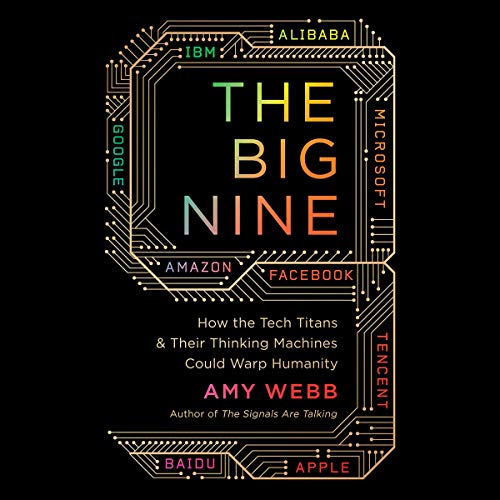Print | Kindle(eBook) | Audiobook
Title: The Big Nine: How the Tech Titans and Their Thinking Machines Could Warp Humanity
Author: Amy Webb
In The Big Nine: How the Tech Titans and Their Thinking Machines Could Warp Humanity, American Futurist and Author Amy Webb writes about the broken nature of artificial intelligence and how powerful corporations she calls the Big Nine; are turning the human-machine relationship on its head. According to Amy, the Big Nine corporation includes 6 American corporations and 3 Chinese companies. The American portion (G-MAFIA – Google, Microsoft, Amazon, Facebook, IBM, and Apple) and the Chinese portion (BAT – Baidu, Alibaba, and Tencent).
The American G-MAFIA companies are beholden to the whims of Wall Street, and they have a transactional relationship with the American Government. In contrast, the Chinese BAT companies are controlled by the Chinese Government and the demands of the Chinese Communist Party. At the center of all these is the consumer whose data is mined and refined to build the future of Artificial Intelligence.
The Big Nine companies may be after the same noble goals—cracking the code of machine intelligence to build systems capable of humanlike thought—but the eventual outcome of that work could irrevocably harm humanity.
Favourite Takeaways – The Big Nine by Amy Webb.
The AI Revolution
Artificial intelligence is already here, but it didn’t show up as we all expected. It is the quiet backbone of our financial systems, the power grid, and the retail supply chain. It is the invisible infrastructure that directs us through traffic, finds the right meaning in our mistyped words, and determines what we should buy, watch, listen to, and read. It is technology upon which our future is being built because it intersects with every aspect of our lives: health and medicine, housing, agriculture, transportation, sports, and even love, sex, and death.
“AI isn’t a tech trend, a buzzword, or a temporary distraction—it is the third era of computing. We are in the midst of significant transformation, not unlike the generation who lived through the Industrial Revolution.“
Contrasting AI Worldview – USA vs China
In the US, relentless market demands and unrealistic expectations for new products and services have made long-term planning impossible. We expect Google, Amazon, Apple, Facebook, Microsoft, and IBM to make bold new AI product announcements at their annual conferences, as though R&D breakthroughs can be scheduled. If these companies don’t present us with shinier products than the previous year, we talk about them as if they’re failures. Or we question whether AI is over. Or we question their leadership. Not once have we given these companies a few years to hunker down and work without requiring them to dazzle us at regular intervals.
The US government has no grand strategy for AI nor for our longer-term futures.
Rather than treating AI as an opportunity for new job creation and growth, American lawmakers see only widespread technological unemployment. In turn they blame US tech giants, when they could invite these companies to participate in the uppermost levels of strategic planning (such as it exists) within the government. Our AI pioneers have no choice but to constantly compete with each other for a trusted, direct connection with you, me, our schools, our hospitals, our cities, and our businesses.
Instead of funding basic research into AI, the US government has effectively outsourced R&D to the commercial sector and the whims of Wall Street.
China AI Strategy
Meanwhile, in China, AI’s developmental track is tethered to the grand ambitions of government. China is quickly laying the groundwork to become the world’s unchallenged AI hegemon. In July 2017, the Chinese government unveiled its Next Generation Artificial Intelligence Development Plan to become the global leader in AI by the year 2030 with a domestic industry worth at least $150 billion, which involved devoting part of its sovereign wealth fund to new labs and startups, as well as new schools launching specifically to train China’s next generation of AI talent.
In October of that same year, China’s President Xi Jinping explained his plans for AI and big data during a detailed speech to thousands of party officials. AI, he said, would help China transition into one of the most advanced economies in the world. Already, China’s economy is 30 times larger than it was just three decades ago. Baidu, Tencent, and Alibaba may be publicly traded giants, but typical of all large Chinese companies, they must bend to the will of Beijing.
China’s AI push is part of a coordinated attempt to create a new world order led by President Xi, while market forces and consumerism are the primary drivers in America. This dichotomy is a serious blind spot for us all.
America’s Tribes: The G-MAFIA
The US-based portion of the Big Nine—Google, Microsoft, Amazon, Facebook, IBM, and Apple—are inventive, innovative, and largely responsible for the biggest advancements in AI. They do function as a mafia in the purest (but not pejorative) sense: it’s a closed supernetwork of people with similar interests and backgrounds working within one field who have a controlling influence over our futures.
With the data you’re generating in the cloud, the G-MAFIA could theoretically tell if you’re secretly pregnant, if your employees think you’re incompetent, or if you’re grappling with a terminal illness—and the G-MAFIA’s AI would probably know all of that well before you do. The godlike view the G-MAFIA have into our lives is not necessarily bad. In fact, there are numerous ways that mining our personal data for insights could result in all of us living healthier, happier lives.
China’s Tribes: The BAT
Baidu, Alibaba, and Tencent, collectively known as the BAT, are China’s side of the Big Nine. The AI tribe under the People’s Republic of China operates under different rules and rituals, which include significant government funding, oversight, and industrial policies designed to propel the BAT forward. Together, they are part of a well-capitalized, highly organized state-level AI plan for the future, one in which the government wields tremendous control. This is China’s space race, and we are its Sputnik to their Apollo mission. We might have gotten to orbit first, but China has put its sovereign wealth fund, education system, citizens, and national pride on the line in its pursuit of AI.
Facebook may have 2 billion monthly active users, but those users are spread out around the world. Tencent’s WeChat’s 1 billion active users are predominantly located in just one country. Baidu had 665 million mobile search users in 201737—more than double the estimated number of mobile users in the United States.3
Humanity
Humanity is facing an existential crisis in a very literal sense, because no one is addressing a simple question that has been fundamental to AI since its very inception: What happens to society when we transfer power to a system built by a small group of people that is designed to make decisions for everyone? What happens when those decisions are biased toward market forces or an ambitious political party? The answer is reflected in the future opportunities we have, the ways in which we are denied access, the social conventions within our societies, the rules by which our economies operate, and even the way we relate to other people.
Every person alive today can play a critical role in the future of artificial intelligence. The decisions we make about AI now—even the seemingly small ones—will forever change the course of human history. As the machines awaken, we may realize that in spite of our hopes and altruistic ambitions, our AI systems turned out to be catastrophically bad for humanity.
The Big Nine aren’t the villains in this story. In fact, they are our best hope for the future.
AI Bias
The future of AI is being built by a relatively few like-minded people within small, insulated groups. But as with all insulated groups that work closely together, their unconscious biases and myopia tend to become new systems of belief and accepted behaviors over time. What might have in the past felt unusual—wrong, even—becomes normalized as everyday thinking. And that thinking is what’s being programmed into our machines.
Those working within AI belong to a tribe of sorts. They are people living and working in North America and in China. They attend the same universities. They adhere to a set of social rules. The tribes are overwhelmingly homogenous. They are affluent and highly educated. Their members are mostly male. Their leaders—executive officers, board members, senior managers—are, with few exceptions, all men. Homogeneity is also an issue in China, where tribe members are predominantly Chinese.
The problem with tribes is what makes them so powerful. In insular groups, cognitive biases become magnified and further entrenched, and they slip past awareness. Cognitive biases are a stand-in for rational thought, which slows our thinking down and takes more energy.
The more connected and established a tribe becomes, the more normal its groupthink and behavior seems.
The AI Systems
The Big Nine AI tribes are building:
Artificial narrow intelligence (ANI) systems, capable of performing a singular task at the same level or better than we humans can. Commercial ANI applications—and by extension, the tribe—are already making decisions for us in our email inboxes, when we search for things on the internet, when we take photos with our phones, as we drive our cars, and when we apply for credit cards or loans.
Artificial general intelligence (AGI) systems, which will perform broader cognitive tasks because they are machines that are designed to think like we do. But who, exactly, is the “we” these AI systems are being modeled on? Whose values, ideals, and worldviews are being taught. The short answer is not yours—and also not mine. Artificial intelligence has the mind of its tribe, prioritizing its creators’ values, ideals, and worldviews. But it is also starting to develop a mind of its own.
Conclusion
The Big Nine—China’s BAT (Baidu, Alibaba, and Tencent) and America’s G-MAFIA (Google, Microsoft, Amazon, Facebook, IBM, and Apple)—are developing the tools and built environment that will power the future of artificial intelligence. They are members of the AI tribe, formed in universities where they inculcate shared ideas and goals, which become even more entrenched once graduates enter the workforce. The field of AI isn’t static. As artificial narrow intelligence evolves into artificial general intelligence, the Big Nine are developing new kinds of hardware systems and recruiting developers who get locked into their frameworks.
AI’s consumerism model in the United States isn’t inherently evil. Neither is China’s government-centralized model. AI itself isn’t necessarily harmful to society. However, the G-MAFIA are profit-driven, publicly traded companies that must answer to Wall Street, regardless of the altruistic intentions of their leaders and employees. In China, the BAT are beholden to the Chinese government, which has already decided what’s best for the Chinese.
All the Best in your quest to get Better. Don’t Settle: Live with Passion.



Comments are closed.